There are many ways of planting potatoes: under the straw in the garden without the hassle, the method that was invented and successfully used by supporters of natural farming. No less original options for planting bags, pit, barrel.
Table of contents
The classic way: how to plant
Consider the classic method of growing potatoes under the straw, which is used by most of the summer residents.

We will decide where to start and how the process goes step by step.
Preparing the soil in the winter
We start cooking land in the fall. Sow rye by removing vegetables and clearing land from plant waste. Seeds zavoronit rake. Winter rye rises quickly. For the winter it does not need to be cleaned, since in the spring it will continue to grow.
It is estimated that before sowing potatoes, rye at a site of 10 x 10 m increases about 200 kg of green mass. The benefits that you get by sowing rye in the fall:
- in the land, the percentage of pests and pathogens of vegetable crops is reduced;
- the amount of weed decreases;
- green mass embedded in the ground serves as an excellent fertilizer.
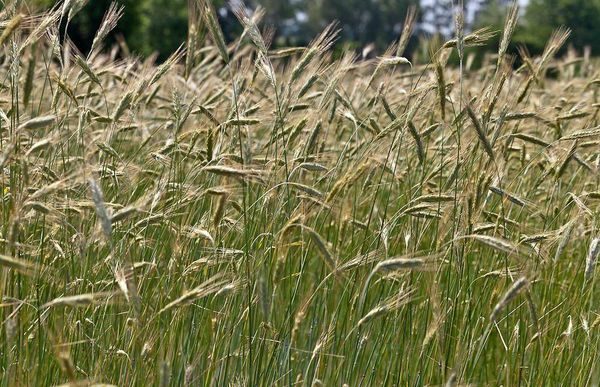
How to prepare planting material
March is coming - time to prepare seed potatoes. Inspection is the first thing to do. Discard potatoes with signs of infection. Leave healthy chicken-sized seeds.
Prepare a solution of pink manganese. Hold the tubers in it (15-20 min), dry, put in boxes. If there is sawdust, then on wet sawdust.
Three weeks boxes should stand in a bright room. The optimum temperature for germination is from 5 to 15 ° C. During this time, the tubers must grow green and be covered with strong shoots. Good consider sprouts that do not exceed a length of 12 cm.
We prepare hay and straw
Hay, dry lawn grass can be used. In general, it contains more nutrients.
You can successfully use second-hand straw that did not break through last season. Before storage, it is well dried, covered for the winter. By May 10, weeds sprout.
We are planting potatoes
Bringing the top layer of the earth, rye embedded in the ground. Outline the rows. To sustain an interval between ranks - 60 cm.
- In the ground to make shallow grooves (8 cm) for laying potatoes.
- Spread the tubers in them, observing a step of 30 cm.
- Cover the grooves with a layer of straw (20 cm).
- For spring tillage, you will need a Fokin flat cutter or a hand cultivator.
If the weather is dry, then before laying potatoes furrows can be watered.
- Ploskorez Fokina
- Hand cultivator
- Furrows with tubers
- Furrows under the straw
The disadvantages of the method
There are few disadvantages, but they are there, you need to know them:
- potatoes turn green if the layer of mulch is thin;
- for growing potatoes on a big field you need a lot of straw;
- rodents can be got.
Alternative method of growing under straw
Tubers sprinkled with earth - this is the main thing that distinguishes the alternative method from the classical method.
In the area designated for potatoes, wells are formed (8 cm). The step is 30 cm, the distance between the rows is 60 cm. Potatoes are laid out in them, sprinkled with earth and the entire area is covered with a layer of straw (25 cm).
Lay out the tubers carefully, without damaging the sprouts. Make sure they look up.
Minimum straw to plant
Planting in the ridge will reduce the consumption of material at times. First form the ridges. The height of the ridge 10 cm, width - 20 cm. The holes are made in the ridge. Tubers cover with a layer of earth and straw, which is placed between the ridges.
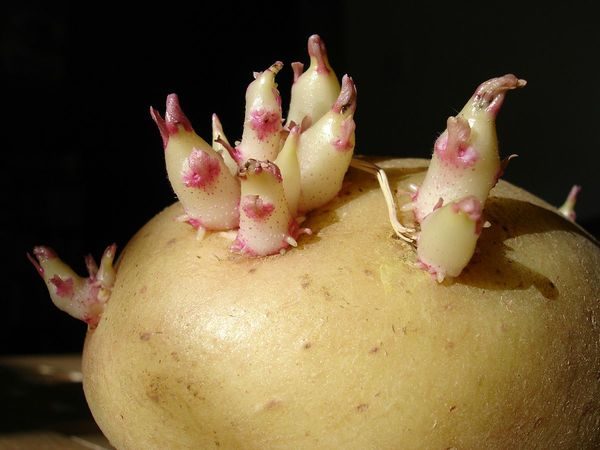
Straw needs less with this method of planting, but the tubers do not turn green, the moisture in the ground is preserved, the weeds germinate more slowly and in smaller quantities.
How to grow with cardboard and straw
Household cardboardThey make boxes for household appliances, suitable for planting potatoes. They need to close the entire area of the ridge. Before laying on the ground on cardboard, make cross-sections.
It will take a clerical knife. Holes position at 30 cm intervals both in a row and between rows. The process of planting potatoes consists in carefully placing the tubers in the holes and covering the “cardboard” ridge with straw.
Features of the harvest
Instead of a shovel, a rake is needed, which can be quite easily pushed off from the ridge of the finished mulch. It remains only to harvest. Tubers are practically on the surface.
From one nest you can get at least 12 potatoes. Tubers are clean, large, rarely affected by disease and therefore are well stored in winter.
Pros and cons of planting under straw
The method provides a significant saving of time for care, as there is no need for hilling, loosening, weeding.
Consider other positive points.Those who will convince to use the way to plant under the straw:
- It is not necessary to dig deep soil; this preserves its fertility and reduces the time and effort required to prepare the site for planting.
- The need for watering decreasesas the mulch well holds moisture, interferes with its evaporation.
- It is noted that the population of the Colorado potato beetle is declining. Culture under hay suffers from the Colorado potato beetle less and to a lesser extent.
- Wet hay disappears, decomposes, releases nutrients necessary for the growth and formation of tubers.
Need to evaluate and cons - costs of this technology. The main disadvantage is the volume that a gardener needs to have on hand throughout the season.
What can lead to its lack of clear. A large percentage will turn green.
- Tubers turn green with long exposure to sunlight.
- Green potatoes are harmful to humans due to the high content of solanine poison
- Solanine, though harmful to humans, but deters pests and rodents
Such potatoes are not eaten, they are used only as seed. Rodents settled in the straw can spoil a part of the crop. Fighting them should be included in the work of caring for the plantation.
Options for planting under straw
Hay used for planting back in the old days. The climate and soil are different everywhere, so there are several ways of planting according to our method:
- classic planting method with tillage;
- planting on virgin soil;
- landing in the ridge;
- relatively new method using cardboard.
- Under the straw
- On virgin soil
- In the comb
- With cardboard
Using the method in the garden without the hassle
There is a correct experience of using dry reed stalks for growing on ridges, which shows:
- Using hay gives an increase in the fertile layer. Cellulose (fiber) contributes to this. She is - food for soil microorganisms, which process it, at the same time carbon is released - a source of energy and life for plants and all living things in the upper fertile layer.
- To ensure a family with potatoes, it is not necessary to plant a field. Several ridges on a plot of 3 x 3 m are capable of providing a family of 3-4 people with potatoes.
- According to statistics, one bucket of seed varieties planted under straw gives a yield of up to 10 buckets.
Plus technology - next year at this place you can plant melons, carrots, beets or cabbage. Crop rotation will be observed. The soil when planting potatoes will receive an additional supply of nutrients.
Description of technology: under the straw
The essence of the technology of planting hay is to replace the ground, which is filled with tubers in the traditional method, a mulch layer of any dry grass.
Throwing a row of potatoes will need several times. The first time - in the spring when landing, several times - during the summer. This is necessary for two reasons: the hay is overheating and the layer becomes thinner, the potato is growing and requires additional shelter.
So the potato bush is fully developed. Large tubers are formed on it. This is possible because the mulch:
- overheating, provides the plant with the nutrients necessary for growth;
- retains moisture;
- holding back the growth of weeds;
- protects the tubers from the sun and overheating.
If you are not sure of success, you can try out the method for hay, which received a second life, on a small ridge. If the result is convincing, the area of the experiment for the next season can be increased.
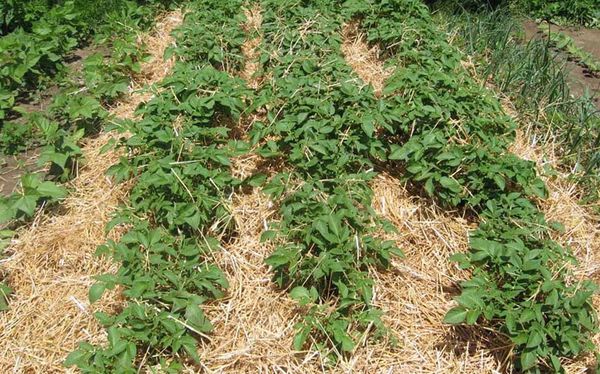
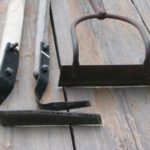
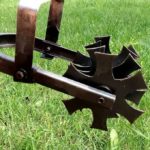
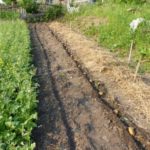
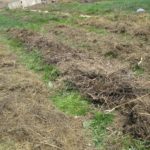
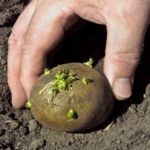
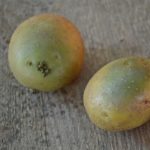
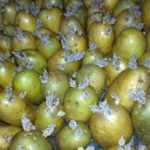
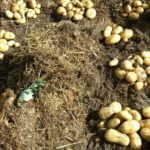
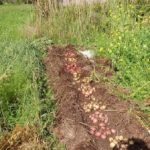
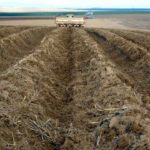
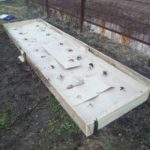
Dear gardeners! I planted potatoes for hay - the result: an incredible amount of slugs, moles and other living creatures was divorced.Do not do this, especially if the place is wet. Now I am engaged in harvesting straw, bought repellents, I will work the soil from slugs. So think a thousand times !!!